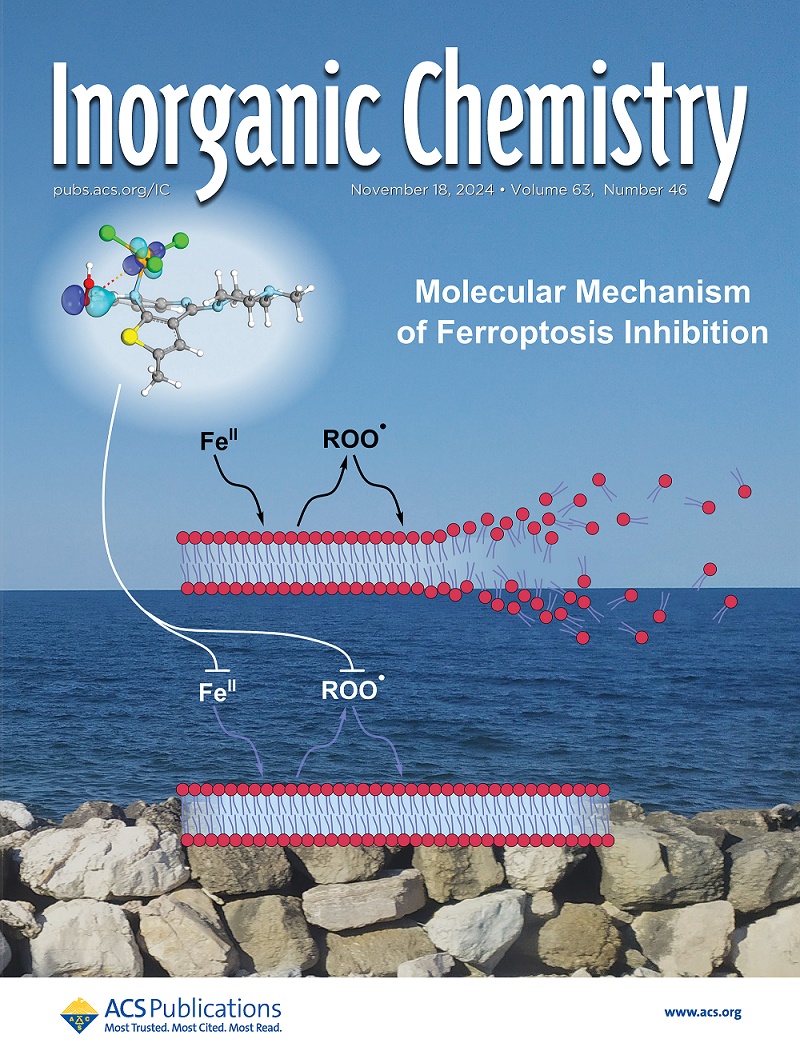Efficiency of Photodissociation of Carbonyl Ligand in Ruthenium Monocarbonyl Bipyridine Complexes: Effect of Isomeric Structures and Ligands.
IF 4.7
2区 化学
Q1 CHEMISTRY, INORGANIC & NUCLEAR
引用次数: 0
Abstract
Photoactivated CO-releasing molecules have potential medical applications. trans(Cl,Cl)-[Ru(bpy)(CO)2Cl2] (bpy = 2,2'-bipyridine) efficiently releases the first CO ligand (∼100% quantum yield), but the second CO dissociation is inefficient, and its precise quantum yield remains undetermined. Photodissociation of trans(Cl,Cl)-[Ru(bpy)(CO)2Cl2] yielded two monocarbonyl complexes, cis(Cl,Cl),trans(Cl,CH3CN)-[Ru(bpy)(CO)(CH3CN)Cl2] and trans(Cl,Cl)-[Ru(bpy)(CO)(CH3CN)Cl2], as the major and minor stereoisomeric products, respectively. The apparent quantum yields for the second CO dissociations were 0.56% and 0.78% for cis(Cl,Cl),trans(Cl,CH3CN)- and trans(Cl,Cl)-isomers, respectively. Considering the efficient photoisomerization of the trans(Cl,Cl)- to cis(Cl,Cl),trans(Cl,CH3CN)-isomer, the trans(Cl,Cl)-isomer would have a higher quantum yield. We also isolated the monocarbonyl complex after the first CO dissociation of trans(Cl,Cl)-[Ru(6Mes-bpy)(CO)2Cl2] (6Mes-bpy = 6,6'-dimesityl-2,2'-bipyridine), which contains bulky substituents at the 6,6'-positions of the bpy ligand. X-ray crystal structure analysis revealed the selective formation of trans(Cl,Cl)-[Ru(6Mes-bpy)(CO)(CH3CN)Cl2]. The quantum yield for the second CO dissociation from this structure was found to be 2.0%, nearly four times larger than that of cis(Cl,Cl),trans(Cl,CH3CN)-[Ru(bpy)(CO)(CH3CN)Cl2]. Time-resolved IR (TRIR) measurements demonstrated that photoirradiation of cis(Cl,Cl),trans(Cl,CH3CN)-[Ru(bpy)(CO)(CH3CN)Cl2] produced a five-coordinate pyramidal square intermediate with a stronger Ru-CO bond than in the ground state. In contrast, no such intermediate was observed for trans(Cl,Cl)-[Ru(6Mes-bpy)(CO)(CH3CN)Cl2]. The presence of this intermediate is thought to be a key factor in inhibiting further CO dissociation.钌单羰基联吡啶配合物中羰基配体的光解效率:异构体结构和配体的影响。
光活化co释放分子具有潜在的医学应用。反式(Cl,Cl)-[Ru(bpy)(CO)2Cl2] (bpy = 2,2'-联吡啶)有效释放第一CO配体(量子产率~ 100%),但第二CO解离效率低,其精确量子产率尚不确定。反式(Cl,Cl)-[Ru(bpy)(CO)2Cl2]光解反应产生顺式(Cl,Cl)、反式(Cl,CH3CN)-[Ru(bpy)(CO)(CH3CN)Cl2]和反式(Cl,Cl)-[Ru(bpy)(CO)(CH3CN)Cl2]两个单羰基配合物,分别为主立体异构体产物和次立体异构体产物。顺式(Cl,Cl)、反式(Cl,CH3CN)-和反式(Cl,Cl)-异构体第二次CO解离的表观量子产率分别为0.56%和0.78%。考虑到反式(Cl,Cl)-有效光异构为顺式(Cl,Cl),反式(Cl,CH3CN)-异构体,反式(Cl,Cl)-异构体具有更高的量子产率。我们还分离了反式(Cl,Cl)-[Ru(6Mes-bpy)(CO)2Cl2] (6Mes-bpy = 6,6'- diesityl -2,2'-联吡啶)首次CO解离后的单羰基配合物,该配合物在bpy配体的6,6'-位置含有大量取代基。x射线晶体结构分析揭示了反式(Cl,Cl)-[Ru(6mes - by)(CO)(CH3CN)Cl2]的选择性形成。该结构第二次CO解离的量子产率为2.0%,比顺式(Cl,Cl),反式(Cl,CH3CN)-[Ru(bpy)(CO)(CH3CN)Cl2]的量子产率大近4倍。时间分辨红外(TRIR)测量表明,顺式(Cl,Cl),反式(Cl,CH3CN)-[Ru(bpy)(CO)(CH3CN)Cl2]光照射产生了一个五坐标锥体正方形中间体,其Ru-CO键比基态时更强。相反,反式(Cl,Cl)-[Ru(6Mes-bpy)(CO)(CH3CN)Cl2]则没有这样的中间体。这种中间体的存在被认为是抑制CO进一步解离的关键因素。
本文章由计算机程序翻译,如有差异,请以英文原文为准。
求助全文
约1分钟内获得全文
求助全文
来源期刊

Inorganic Chemistry
化学-无机化学与核化学
CiteScore
7.60
自引率
13.00%
发文量
1960
审稿时长
1.9 months
期刊介绍:
Inorganic Chemistry publishes fundamental studies in all phases of inorganic chemistry. Coverage includes experimental and theoretical reports on quantitative studies of structure and thermodynamics, kinetics, mechanisms of inorganic reactions, bioinorganic chemistry, and relevant aspects of organometallic chemistry, solid-state phenomena, and chemical bonding theory. Emphasis is placed on the synthesis, structure, thermodynamics, reactivity, spectroscopy, and bonding properties of significant new and known compounds.
 求助内容:
求助内容: 应助结果提醒方式:
应助结果提醒方式:


